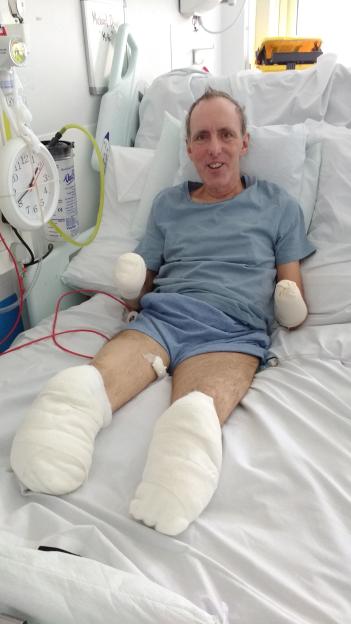JOINT flexibility is important for healthy movement and function.
But being able to move your joints in an extraordinary way could be a sign of Ehlers-Danlos syndromes (EDS).
 A simple finger test can reveal if you’re at risk of Ehlers-Danlos syndromes
A simple finger test can reveal if you’re at risk of Ehlers-Danlos syndromes EDS makes joints hypermobile and skin can be stretched further than normal
EDS makes joints hypermobile and skin can be stretched further than normalEDS area group of inherited disorders that affect connective tissues, primarily the skin, joints, and blood vessels.
These disorders result from genetic mutations that impact the production or structure of collagen, a key protein that provides support and structure to various tissues.
EDS is characterised by joint hypermobility â an increased range of motion in the joints, making them more flexible than average.
Skin can stretch further than normal, joints bend too far and sometimes dislocate, and internal tissues bruise or tear more easily.
According to Jeannie Di Bon, a UK-based hypermobility and EDS specialist, just because you’re hypermobile doesn’t automatically mean something’s wrong with your connective tissue or that you’ve got a syndrome.
But if hypermobility begins to really bother you and suddenly becomes very problematic (often overnight), it could be cause for investigation for a connective tissue disorder, such as EDS, Di Bon told Newsweek .
Easy test for hypermobility
 If your thumb can be bent backward so that it touches or goes beyond the palm of your hand or wrist it could mean you have greater joint hypermobility
If your thumb can be bent backward so that it touches or goes beyond the palm of your hand or wrist it could mean you have greater joint hypermobilityThe nine-point Beighton score isa simple assessment tool used to evaluate joint hypermobility.
It involves testing the flexibility of several joints, with each positive result adding a point to the score.
A higher score generally indicates greater joint hypermobility.
The score is calculated by adding up the points earned for each of the five tests.
- If the finger can be bent back more than 90 degrees âone point for each hand.
- If the thumb can be bent backward so that it touches or goes beyond the palm of the hand or wrist â one point for each hand.
- Being able to extend the elbow beyond 10 degrees â one point for each elbow.
- Being able to extend the knee beyond 10 degrees â one point for each knee.
- The ability to bend forward from the waist, with knees fully extended, and touch the palms flat on the floorâ one point if the palms can touch the floor.
A score of more than five out of nine, for an adult, indicates a person has hypermobility.
For a child, it’s a score of at least six out of nine.
The score alone doesn’t confirm EDS.
A hypermobile-EDS diagnosis is “based on a checklist where the patient meets certain criteria, including a Brighton score level,”; Dr Bernadetteâ¯Riley, director of the EhlersâDanlos Syndrome/Hypermobility Treatment Center at Institute of Technology‘s College of Osteopathic Medicine, toldNewsweek.
Official figures for diagnosed cases of EDS in the UK are around 135,000 to 300,000.
The actual number of people living with the condition is likely higher due to underdiagnosis and misdiagnosis.
EDS can manifest at different ages, depending on the specific type, withsome forms being evident at birth and others not being diagnosed until adulthood.
While symptoms of inherited EDS can be present at birth, they may not be noticeable until puberty.
Some milder forms are often not diagnosed until early adulthood, while more severe types are typically diagnosed in childhood.
People with EDS have also been found to be more susceptible to respiratory issues, including a range of symptoms from shortness of breath and limitations to conditions like pneumothorax.
A 2022 study published inRespiratory Medicine and Researchfound that almost 85 percent of EDS patients had signs of respiratory problems.
And conditions are also widely reported among EDS patients.
Another 2022 study found almost half of the EDS patients surveyed had and over half had “probable”; anxiety.
There’s no cure for EDS, however, various treatments and lifestyle adjustments can help manage symptoms, prevent complications, and improve quality of life.






